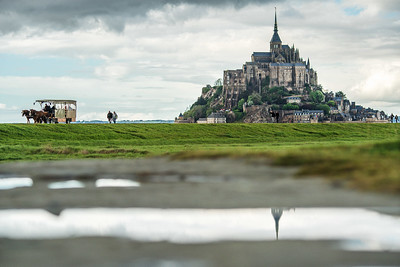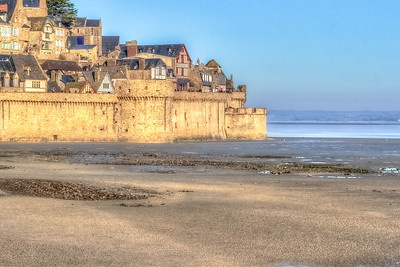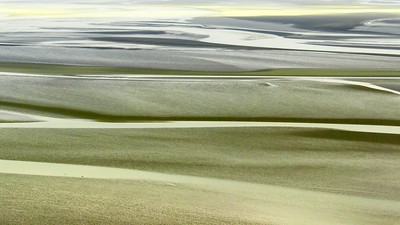One of the most extraordinary sights in France, indeed in all of Europe – Mont Saint-Michel. Victor Hugo called Mont Saint-Michel the “pyramid of the sea” and that says it all. For it offers a double spectacle: a unique cultural monument with an eventful history in the midst of an equally fascinating natural landscape.
Discover now:
Plan Your Trip

Mont Saint-Michel is located in the far north-west of Normandy, just a few kilometres from the border with Brittany. If you are travelling from Germany by car, the A84 leads from Caen to the bay with the monastery mountain. Those wishing to make a detour from their holiday in Brittany arrive via Saint-Malo on the N12 or N176. Regardless of the direction from which visitors arrive by car, guidance systems lead them to the large official car park with around 4,000 parking spaces. In addition to this parking facility next to the visitor centre, there are a number of smaller car parks.
24-hour parking near Mont Saint-Michel costs 9.10 EUR for regular cars or 14.20 EUR in high season. Campers pay 12.10 EUR or 17.80 EUR.
It takes about 35 minutes to walk from the large car park to Mont Saint-Michel. Alternatively, you can use the closely timed shuttle buses that leave from each of the car parks. Or the horse-drawn carriages, which also start from the “parking” and complete the journey in about 20 minutes.
You can also travel by train, the nearest regional train station is in Pontorson. From here, there are bus connections to the large car park. The car park is also the destination of buses departing from Rennes or Dol de Bretagne railway stations. And a bus also leaves from Saint-Malo once a day to Mont Saint-Michel in about 75 minutes.
One last option should be mentioned here: getting there by bike. The sight is located directly on the EuroVelo E4 cycle route, which starts in Ukraine and follows the French Channel coast on its final section.
Buy Tickets

Visiting the island is free, but entry to the main attraction, Mont Saint-Michel Abbey, is not. Most groups of visitors have to buy a ticket. Regular admission costs an adult 10 EUR, young people up to 25 years pay 8 EUR. Young people up to the age of 18 visit the World Heritage Site for free. An audio guide can be rented for an additional 3 EUR – well worth it.
It is advisable to order tickets online in advance to avoid long queues. Print out the purchased e-tickets or show them on your smartphone. From 9:30 a.m., the gates of the Klosterberg are open to visitors. Last admission is at 5:30 pm.
These tickets entitle the holder to stay in the Abbaye. Extra fees apply for museums.
Tour
Visitors enter through the gate “Porte de l’Avancée” in the south. Passing 2 large bombarde, which the inhabitants captured from the English during the Hundred Years’ War, you reach the Porte du Roy. Either you enter the town through this gate and you are on the Grand Rue, the main street of the town. Or the path leads up a few steps to the Tour du Roy and onto the accessible fortification wall that encloses large parts of the town.
Heading north – past 5 more towers – you reach the Tour du Nord right next to the entrance to the abbey. Heading west, the path leads to the Tour Gabriel, a fortified tower worth seeing, comparatively quiet in the hustle and bustle of the tourist crowds. From the “remparts”, the view expands over the Baie du Mont Saint-Michel. The panorama is particularly spectacular when the water washes back into the bay at high tide.
The only alternative to walking over the fortifications is to take the Grand Rue. The Grand Rue is lined with medieval houses. As in the few small alleys leading off the main street, restaurants and souvenir shops dominate the Grand Rue. This winding, ascending, sometimes wider, sometimes narrower lane leads to the abbey of Mont Saint-Michel.
Filmed tours can be seen on YouTube, the tours with the camera give a realistic impression of Mont Saint-Michel:
Short tour (8 min.):
https://www.youtube.com/watch?v=OjWKd8sc65g
Abbey
What makes the “Abbaye du Mont Saint-Michel” so special is the many architectural styles that can be observed in the layers of the complex. Romanesque, Gothic and Neoclassical elements coexist in the abbey’s many chapels, crypts and corridors.
The abbey is divided into 3 levels. The lowest section, dating from the early 11th century, is the earliest and contains a storage cellar, the Aquilon crypt and a hall that was reserved for pilgrims.
Between the lower and middle levels is the chapel of Notre-Dame-sous-Terre, the most important religious place before the present abbey church was built on the top level. On the middle level are the so-called Knights’ Hall, the monks’ ambulatory, the Chapel of the 30 Candles and the “Crypt of the Thick Pillars”.
The crowning glory of the abbey is the top level with the former sleeping and dining hall of the monks of Mont Saint-Michel, the cloister and the impressive abbey church. With a few exceptions, the abbey’s rooms are open to visitors. At least 2 hours should be planned to discover the intricate buildings and rooms at leisure – preferably early in the morning, as soon as the gates open.
Museums
On the grounds of Mont Saint-Michel, 4 privately run museums are open to visitors – for an additional fee. The Archéoscope, the Logis Tiphaine, the Musée Historique and the Musée Maritime can complement your stay, but they are not essential.
The Archéoscope opposite the church of Mont Saint-Michel advertises that it will guide visitors through the island mountain’s eventful past with a multimedia show. In fact, the lighting effects and videos presented do not always meet the standards of the 2020s.
The Logis Tiphaine was the historic home of the knight Bertrand du Guesclin and his wife Tiphaine de Raguenel. He was a leader of the French armies in the Hundred Years’ War, she a famous astrologer of the 14th century. On display in a total of 6 rooms are furniture of the period, significant symbolic objects such as a chastity belt from the Middle Ages or the armour of Bertrand du Guesclin.
In the Musée Historique, visitors will find exhibits and replicas illustrating the history of the Inselberg. Wax figures of monks and prisoners are just as much a part of it as weapons and instruments of torture from earlier times.
The Musée Maritime is located at the lower end of the Grand Rue and is aimed at fans of model ships. 250 different “maquettes” of historic ships and boats are on display here.
The most interesting thing is to see the buildings housing the exhibits from the inside, even if some of the rooms are in need of renovation. As real museums, the exhibitions fall short in many places. Interested visitors often wish for further explanations, especially in several languages, to help them understand what is on display. Contemporary ways of bringing the historical material to life – for example, through contemporary multimedia offerings or interactive formats – are also mostly missing.
Tickets for the museums are available on site; single tickets cost 9 EUR for an adult, while young people under 18 can visit the museums free of charge. The purchase of a combination ticket for 18 EUR entitles adults to visit all 4 exhibitions.
History Of Mont Saint-Michel
Ever since Christianity penetrated the region in the 4th century, God-fearing men lived on Mont Tombe off the coast of what is now Normandy. The small island, sparsely overgrown with trees, belonged to the diocese of Avranches when, according to legend, its bishop Saint Aubert saw the Archangel Michael in a dream in 708. The angel ordered him to build a chapel, Saint Aubert decided on Mont Tombe.
On Saint Michael’s instructions, the building was to be modelled on the most important monastery dedicated to him at the time, Monte Gargano in Italy. The bishop sent two monks to Apulia to ask for relics. After their return, Mont Saint-Michel was given its name and construction began.
A simple church was built, the remains of which can still be seen today in the later church of Notre-Dame-Sous-Terre. In the centuries following the founding father Saint-Aubert, Mont Saint-Michel increasingly became a centre of attraction for pilgrims.
More buildings were built to cope with the influx. Under Viking attack in the 9th and 10th centuries, the island’s buildings were initially damaged (it was never completely conquered), only to be rebuilt thanks to generous donations from the Norman rulers.
Splendour and prosperity subsequently attracted secular visitors and affected religious life in seclusion. From the middle of the 10th century, the Norman princes installed monks of the Benedictine order on Mont Saint-Michel.
The Benedictines founded the abbey – even today, the mighty structure is the landmark and centre of the island. A phase of growth set in, culminating in the years from 1100 onwards: the monastery was continually expanded, thanks to the bountiful donations of pilgrims and nobles, and numerous other buildings were also erected at the foot of the abbey.
The construction period of a particular showpiece dates from 1211 to 1228. The parts of the abbey on the north side that can be attributed to the Gothic style are known as “La Merveille” (“The Miracle”). The knights’ hall, guest room, cloister and refectory were built with previously unknown ornamentation.
Externally, the mighty walls strengthened the defences of the complex and gave Mont Saint-Michel a strategic advantage that was to pay off in the Hundred Years’ War between France and England. In the course of the war, the outer walls were further strengthened so that the British did not succeed in completely conquering the island during the conflicts in the 15th century. The fortress also held out during the Huguenot Wars in the 2nd half of the 16th century.
Already during the “Ancien Régime” before the French Revolution, parts of Mont Saint-Michel served as dungeons. After 1790, the island fully became the “Bastille of the Sea”: the Benedictines were expelled and the mighty walls now held up to 700 prisoners. The substance of the buildings suffered from this use, the entire Mont Saint-Michel gradually deteriorated.
In the middle of the 19th century, awareness of the importance of the ensemble as cultural heritage awoke. A campaign led by Victor Hugo, among others, succeeded in getting the prisoners to leave the island. Decades of restoration of the buildings began. Meanwhile, the number of visitors increased: in 1860 only 10,000 tourists came, but by 1890 there were already 100,000 guests. In the 1890s, Mont Saint-Michel received a new landmark: the gold-coloured figure of the Archangel Michael crowning the roof of the abbey was installed in 1898 .
And religious life also returned. Since 1922, religious services were held in the abbey, and in 1966, after the millennium celebration, Benedictine monks lived in the monastery for the first time since the 18th century, even if only for a few years.
For the time being, Mont Saint-Michel experienced a final highlight in its eventful history when the island was declared a UNESCO World Heritage Site in 1979 – as one of the first monuments in the world worthy of protection.
Natural Phenomenon Baie Saint-Michel

The “Baie du Mont Saint-Michel” is a natural phenomenon of a special kind: at low tide, the water from about three quarters of the 40,000-hectare area drains away. During the change of the tides, the sea retreats up to 17 kilometres. When the water flows back, it travels up to 62.5 metres per minute. The tide comes in quickly, but not as rapidly as the much-cited comparison suggests, according to which the water rushes into the bay with the “speed of a galloping horse”.
The reason for this phenomenon is the fact that the bay, which is bordered to the west by the Breton headland near Cancale, is extremely shallow. In addition, the Cotentin peninsula to the east of the Baie acts as a barrier against the water masses of the “Manche Centrale”, the central part of the English Channel.
Three rivers, Couesnon, Sée and Sélune, flow into the bay, which contributes to the unique ecosystem. A large number of bird species live on and in the water (it is estimated that there are about 120,000 birds in total), about 100 species of fish and dog seals.
Trying to get close to the animals on your own during a mudflat hike is extremely risky. On the one hand, because of the rapidly rising tide. On the other hand, because of the places with drifting sand, which change almost with every new tide cycle. It is safer to discover nature from one of the hiking trails along the polders. Hiking here has another advantage: from the edge of the sea, Mont Saint-Michel best unfolds its full glory.
Images: Atout France | © Marc Lerouge, © Nathalie Baetens
Horse coach: Davide Gabino (aka Stròlic Furlàn) |CC BY-ND 2.0
Abbey: Benh LIEU SONG | CC BY-SA 2.0
Bay: Bruno Malfondet | CC BY-ND 2.0
